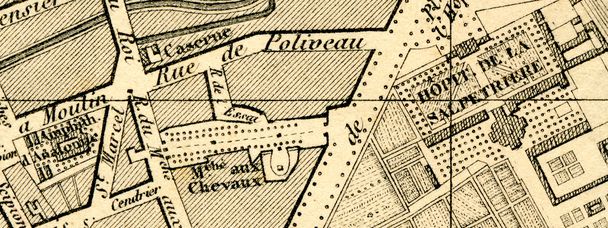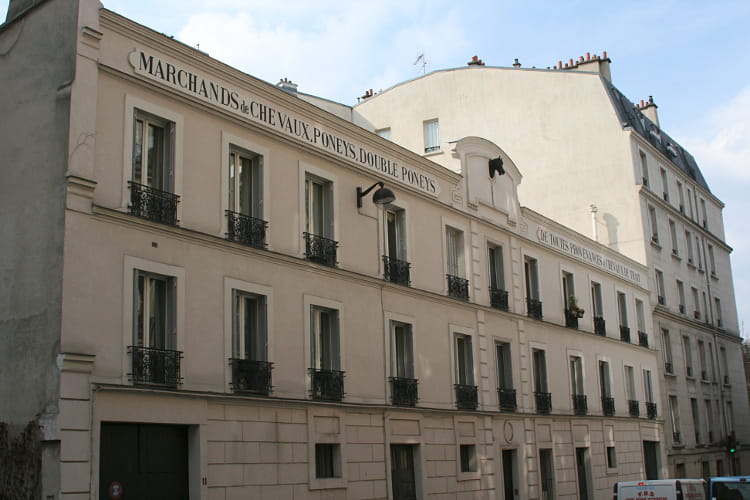Il y a 100 ans, on comptait plus de 80000 chevaux à Paris. C'était la principale énergie motrice utilisée pour le déplacement jusqu'en 1914.
Après avoir occupé plusieurs lieux dans la capitale, le marché aux chevaux s'installe ici en 1687 à l'endroit appelé la Folie-Eschalard ou se trouvait déjà un marché aux porcs.
 "
"
Des travaux successifs jusqu'en 1818 en firent un marché important, avec 2 rangées de stalles pouvant accueillir jusqu'à 500 chevaux sur un terrain aplani et planté d'arbres.
Le marché se tenait tous les mercredis et samedis. Le matin pour les porcs et l'après midi après 15 heures pour les chevaux, les mules et les ânes. Le dimanche était réservé pour les voitures (à cheval) et aussi pour les chiens.

En bordure du marché, le pavillon de la rue Geoffroy Saint-Hilaire fut élevé en 1760 par le lieutenant général de police Sartine pour y loger les contrôleurs chargés de la surveillance du marché (ce même Sartine sera ministre de la marine sous Louis XVI et émigrera en Espagne à la révolution).
Sur ce bâtiment, de part et d'autre de la fenêtre centrale, on peut y observer une grue (la patience), symbole de la police sous l'ancien régime et un coq (la vigilance) même symbole mais après la révolution.
Plus bas dans le rue, vous verrez l’ancienne maison d'un vendeur de chevaux qui atteste l'activité dans le quartier.

Le boulevard Saint-Marcel, crée en 1857, recouvrit l'emplacement du marché et celui-ci fut progressivement déplacé jusqu'à la construction d'un nouveau marché dans un triangle délimité par le boulevard de l'Hôpital, le Bd Saint-Marcel et de la rue Jeanne d'Arc; avec une entrée principale sur le boulevard de l'Hôpital.
Puis vint la voiture, l'activité commença à décroître, et en 1907 le marché est à nouveau déplacé vers Vaugirard pour finalement disparaître, mais ceci est une autre histoire...
English (your help is welcome to improve the translation)
100 years ago, there were more than 80,000 horses in Paris. Horses were the main driving force for the displacement of our ancestors until 1914.
After holding several places in the capital, the horses market moved here in 1687 at Faubourg Saint-Victor at a place called Folie-Eschalard where was already a market for pigs.
Successive works until 1818 made it an important market, with 2 rows of stalls for up to 500 horses on a leveled ground with planted trees. The market was held every Wednesday and Saturday. In the morning for pigs and the afternoon after 15 hours for horses, mules and donkeys, on Sunday for horse cars and also for dogs.
On the edge of the market, the house rue Geoffroy Saint-Hilaire where you are, was built between 1760 and 1762 by Lieutenant-General of Police Sartines to accommodate the controllers responsible for market surveillance (the same Sartines will be Minister for Navy under Louis XVI and will emigrate in Spain during the revolution). On this building, on either side of the central window, you can see a crane, symbol of the police under the "ancien regime" and a rooster, same symbol but after the revolution.
Further down the street you will see the former home of a horse dealer that this activity in the neighborhood. The boulevard Saint-Marcel, created in 1857, finally took the place of the market which was moved further south until the construction of a new market in an area bounded by the Boulevard de l'Hopital, St. Marcel and Jeanne d'Arc; with a main entrance on the Boulevard de l'Hopital.
Then came the car, the horse activity began to decline, and in 1907 the market is moved to Vaugirard (15th district) eventually disappear, but that is another story ...